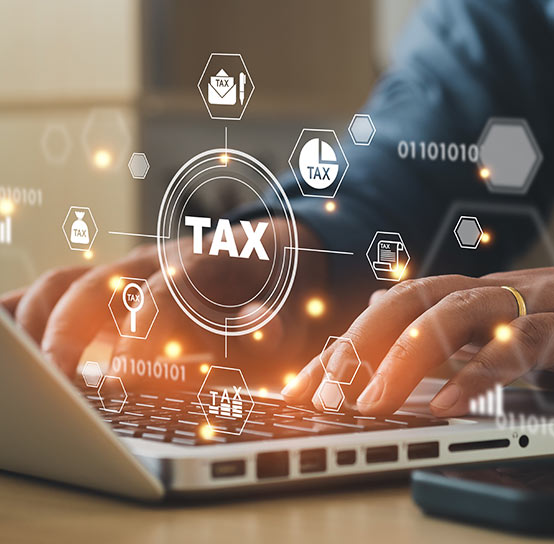-
Business Consulting
Our business consulting specialists offer a comprehensive blend of strategic advisory services. We assess the business, industry, operating model, synergy, skill sets and vision of the organisation and recommend the way forward
-
Digital Natives
Unlock growth with Grant Thornton Bharat's Digital Natives solutions. Customised support for tech-driven companies in healthcare, gaming, and more.
-
Digital Transformation Services
Grant Thornton’s digital transformation services help traditional businesses digitalise their business models with cloud technology, IoT consulting, app development and more DigiTech solutions.
-
Finance Transformation
Using a holistic approach, integrating digitalisation and digital transformation we help clients achieve transparency, control, governance, and faster decision making through real-time data within the business.
-
Human Capital Consulting
Our Human Capital Consulting team harnesses technology and industry expertise to assist in constructing adaptable organisations with transparency, fostering productive and value-driven workforces, and inspiring employees to engage meaningfully in their tasks.
-
Production Linked Incentive Scheme
Production-linked Incentive Scheme by the Indian government is aimed at boosting manufacturing. Grant Thornton Bharat offers varied services across sectors to help businesses avail of this scheme.
-
Public Sector Advisory
Our Public Sector Advisory team has focused streams, aligned with the core priorities of the Government of India. We are responsible for providing innovative and customized technical and managerial solutions.
-
Tech Advisory
We have amalgamated Digital Transformation, IT Advisory & Information Management and Analytics into a new offering, DigiTech.

-
Direct Tax services
Our tax specialists offer a comprehensive blend of tax services, tax litigation, regulatory and compliance services, helping you navigate through complex business matters.
-
Indirect Tax Services
Get tax services by leading tax firm Grant Thornton India. Our indirect tax services include consulting, compliance and litigation services for corporate, international and transaction tax
-
Transfer pricing services
Our transfer pricing services experts provide a range of services from provision of APA services to handling large global assignments including Country by Country reporting.
-
US Tax
At Grant Thornton, we help individuals and dynamic companies deal with US tax laws, which are one of the most complicated tax legislations across the world.
-
Financial Services - Tax
Best financial advisory services, tailored for small and large businesses by the experts having comprehensive knowledge of domestic laws and access to multifaceted tools to provide a valuable results.
-
Financial Reporting consulting services
Our experts have significant hands-on experience in providing IFRS/US GAAP services, end-to-end solutions and support services to fulfil financial reporting requirements.
-
Fund accounting and financial reporting
International operations often lack standardisation and have varied local reporting formats and requirements. Our experts can offer proactive insights, practical guidance, and positive progress and help meet regulatory timeframes.
-
Compliance and Secretarial Services
Our experts can assist in overhauling the entire compliance machinery of the organisation through evaluation of the applicable statutory obligations, monitoring of adequate governance controls, reporting and providing ongoing support.
-
Global People Solutions
As businesses transcend borders, both domestic and global considerations need equal attention. Our interim CFO and financial controller support services help organisations meet the business vision.
-
Finance and accounting outsourcing
Our accounting experts assist organisations in managing their accounting and reporting. Our dedicated Integrated Knowledge and Capability Centre (IKCC), allows us to service both the domestic and global markets efficiently and cost-effectively
-
Compliance Management System
We have automation solutions for you that will allow meeting government requirements and remain diligent, which when failed, can lead to penalties and loss in revenue.
-
Global compliance and reporting solutions
At Grant Thornton Bharat, we meet the challenges of our clients and help them unlock their potential for growth. Our professionals offer solutions tailored to meet our clients’ global accounting and statutory reporting requirements. With first-hand experience of local reporting requirements in more than 145+ locations worldwide, we provide seamless and consistent international service delivery through a single point of contact.
-
Related-party transaction governance
Related-party transactions (RPTs) are common in business structures where organisations engage with their group entities, such as holding companies, subsidiaries, associate concerns, joint ventures, or key management personnel, for various operational or financial purposes.
-
Family Offices & Private Client Services
Grant Thornton Bharat Private Client Services offers tailored advisory for family-owned businesses, focusing on governance, compliance, tax, succession planning, and family office structuring to sustain wealth and preserve legacies across generations.
-
GTMitra: Tax & Regulatory Tool
GTMitra, a specialised tax and regulatory tool by Grant Thornton Bharat, supports multinational businesses in understanding laws and regulations for effective growth strategies.
-
Labour codes
Labour codes solutions help you transition through the new legislation. At Grant Thornton, we help businesses divide their approach to make sure a smooth transition.
-
Alerts
At Grant Thornton India, with the help of our tax alerts, we help to provide updates on how to minimise your tax exposure and risks.
-
Unlocking opportunities: India investment roadmap
The India Investment Roadmap resource is designed to navigate the complexities of Indian tax and regulatory laws, providing seamless guidance and a comprehensive set of solutions to ensure a smooth process for investors aiming to establish or expand their presence in India.
-
CFO Solutions
Our comprehensive suite of solutions for CFOs

-
Cyber
In today’s time, businesses have gone through large transformation initiatives such as adoption of digital technologies, transition to cloud, use of advanced technologies et al.
-
Risk Optimisation
Our Governance, Risk and Operations (GRO) services encompass Internal Audit, Enterprise Risk Management, Internal Financial Controls, IT advisory, Standard Operating Procedures and other services.
-
Risk analytics
Grant Thornton Bharat’s CLEARR Insights is a state-of-the art data analytics platform that will help you in seamless data analysis and efficient decision-making.
-
Forensic & Investigation Services
The team of forensic advisory services experts consists of the best intelligence corporate experts, and fraud risk, computer forensic experts to deliver most effective solutions to dynamic Indian businesses.
-
Digital Forensics and Incident Response (DFIR)
Strengthen cyber resilience with proactive forensic audits
-
ESG consulting
Grant Thornton Bharat offers holistic ESG consulting solutions for sustainable business outcomes. With industry expertise and AI technology, we drive long-term value.

-
Transaction Tax Services
Our transaction tax experts understand your business, anticipate your needs and come up with robust tax solutions that help you achieve business objectives ensuring compliance and efficiency
-
Deal Advisory
Unlike other M&A advisory firm in India, we offer deal advisory services and work exclusively with controlled and well-designed strategies to help businesses grow, expand and create value.
-
Due Diligence
Grant Thornton’s financial due diligence services are aimed at corporate looking for mergers and acquisitions, private equity firms evaluating investments and businesses/promoters considering sale/divestment.
-
Valuations
As one of the leading valuation consultants in India, Grant Thornton specializes in all the aspects of the process like business valuation services, financial reporting, tax issues, etc.
-
Overseas Listing
Overseas listing presents a perfect platform for mid-sized Indian companies with global ambitions. Grant Thornton’s team of experts in listings, work closely with clients during all stages.
-
Debt & Special Situations Solutions
Grant Thornton Bharat offers specialist debt and special situations consulting services, including restructuring, insolvency, and asset tracing solutions.
-
Financial Reporting Advisory Services
Grant Thornton Bharat Financial Reporting Advisory Services offer end-to-end solutions for complex financial requirements, including GAAP conversions, IPO support, and hedge accounting advisory, ensuring accurate financial reporting and compliance.
-
Financial Statement Audit and Attestation Services
Grant Thornton Bharat offers customised financial statement audit and attestation services, ensuring impeccable quality and compliance with global standards. Our partner-led approach, technical expertise, and market credibility ensure effective solutions for your business needs.

- Agriculture
- Asset management
- Automotive and EV
- Banking
- Education and ed-tech
- Energy & Renewables
- Engineering & industrial products
- Fintech
- FMCG & consumer goods
- Food processing
- Gaming
- Healthcare
- Urban infrastructure
- Insurance
- Media
- Medical devices
- Metals & Mining
- NBFC
- Pharma, bio tech & life sciences
- Real estate and REITs
- Retail & E-commerce
- Specialty chemicals
- Sports
- Technology
- Telecom
- Transportation & logistics
- Tourism & hospitality
-
 Thought leadership Co-lending in India: Expanding credit access for MSMEsIn today’s rapidly evolving financial landscape, co-lending has emerged as a key enabler of credit expansion in India, facilitating partnerships between banks and non-banking financial companies (NBFCs) to extend credit more efficiently to underserved segments.
Thought leadership Co-lending in India: Expanding credit access for MSMEsIn today’s rapidly evolving financial landscape, co-lending has emerged as a key enabler of credit expansion in India, facilitating partnerships between banks and non-banking financial companies (NBFCs) to extend credit more efficiently to underserved segments. -
 Article Why India’s financial inclusion journey needs to focus on equity and access to creditFinancial services have expanded over a decade, giving millions access to bank accounts and digital payments. But true empowerment needs to reach every corner of the country if growth is to be long-term and sustained
Article Why India’s financial inclusion journey needs to focus on equity and access to creditFinancial services have expanded over a decade, giving millions access to bank accounts and digital payments. But true empowerment needs to reach every corner of the country if growth is to be long-term and sustained -
 Thought Leadership Competitive and sustainable agriculture & food processing in KeralaThe economy of Kerala is primarily driven by the services sector, which contributes 66% to the Gross State Domestic Product (GSDP).
Thought Leadership Competitive and sustainable agriculture & food processing in KeralaThe economy of Kerala is primarily driven by the services sector, which contributes 66% to the Gross State Domestic Product (GSDP). -
 Article Economic Survey 2024-25: Deregulation, investment and innovation for a Viksit BharatIndia's economic growth remains for a steady trajectory with real GDP expected to grow at 6.4% in FY25 and in the range of 6.3%-6.8% in FY26, reflecting resilience despite global uncertainties.
Article Economic Survey 2024-25: Deregulation, investment and innovation for a Viksit BharatIndia's economic growth remains for a steady trajectory with real GDP expected to grow at 6.4% in FY25 and in the range of 6.3%-6.8% in FY26, reflecting resilience despite global uncertainties.
-
Quarterly Aviation Insights
Explore the latest trends in aviation industry with Grant Thornton Bharat’s Quarterly Aviation Insights. Stay updated on industry growth, market shifts & key developments.

-
India-UK
India-UK

Being the Lok Sabha election year, the 2024 Union Budget on February 1 will be interim or provisional. The automotive industry expects the budget to adopt a growth-oriented strategy, prioritizing the enhancement of capabilities for localization and incentivizing the adoption of alternative fuel solutions. This aligns with the broader objective of achieving 50% energy capacity from renewables by 2030.
In 2023, the Indian automotive industry made significant gains by building upon the healthy growth in 2022. The Passenger Vehicle segment surged 8% by selling over 4 million units, Commercial Vehicle segment 5% with 0.98 million units, and two-wheelers 9% with sales exceeding 17 million units, gradually approaching its previous peak in 2018-19. The three-wheelers grew 63% year-on-year by selling over 0.68 million units in 2023.
This landmark year underscored the industry's resilience and continued upward trajectory. In terms of fuel type, Electric Vehicles (EVs) made the highest Y-o-Y growth of 49% (1.53 million units sold in 2023). Despite challenges such as reduced FAME-II subsidies for the e-2wheeler segment, the industry regained momentum by August 2023.
The auto-component industry also demonstrated robust growth, with a 32.8% increase (USD 69.7 billion) in FY23, driven by domestic demand. EVs constituted approximately 2.7% of its total turnover in this period.
In alignment with India's commitment to green mobility and domestic manufacturing, the EV sector anticipates positive measures in the Interim Budget 2024 to foster industry growth. Presently, EV penetration stands at 1%, and the industry seeks support for expansion. Emphasizing green and sustainable mobility, there's a notable focus on production, utilization, and export of green hydrogen, backed by the Green Hydrogen Mission with a substantial INR 19,700-crore capital outlay.
The interim budget should not only address the current industry challenges but also promote long-term sustainable growth. The Budget can play a pivotal role in supporting the automotive sector's transition by implementing measures to encourage and facilitate this shift.
A few areas where the budget can support the automotive industry to aid this transition are:
Incentives to enhance EV Ecosystem: The EV ecosystem seeks encouragement for enhanced adoption, innovation, and infrastructure challenges. Under FAME-II, the Ministry of Heavy industries (MHI) has disbursed INR 5,228 crore in subsidies for about 1.15 million EVs and an additional INR 800 crore for setting up around 7,500 fast charging stations across the country.
There is much anticipation for clarity on FAME-III subsidy, which is projected to have heightened focus on mass transportation, alternative fuel initiatives and charging infrastructure. Including EVs in Priority Sector Lending (PSLs) to make EV financing more accessible,will also be key in enhancing EV adoption. In addition to the incentives aimed at directly improving EV registrations, the budget should also focus on extending support across the entire EV ecosystem, such as boosting indigenous production, provisions for enabling fast-charging infrastructure uniformly across the country, comprehensive battery swapping policy, and insurance norms tailored for EVs, among others.
Fostering growth for startups and MSMEs: To boost the EV ecosystem among MSMEs and startups, the government should incentivize measures such as facilitating domestic battery manufacturing, promoting skilling initiatives, and providing benefits such as accelerated depreciation and specialised EV financing. With the commercial vehicle industry poised to thrive amidst infrastructure development and e-commerce growth, extending government incentives in this sector can catalyse innovation and foster sustained expansion, driving the production and adoption of electric vehicles among MSMEs.
Thrust on renewable power sector: India needs approximately USD 2.5 trillion in investments by 2030 to keep up with its sustainable energy goals. With the transport sector accounting for around 10% of India’s greenhouse emissions- transition to green mobility, backed by renewable sources is key to reducing carbon footprint. Policy initiatives focusing on research, development, manufacturing, and investments in clean energy solutions like wind and solar can accelerate progress. Supporting these efforts with viability gap funding and low-cost financing through a dedicated green fund will strengthen the transition to sustainable energy.
PLI program for green hydrogen: The nationwide PLI program for green hydrogen is a positive step (hydrogen could contribute to more than 20% of annual global emission reductions by 2050). Th on-going efforts towards indigenous manufacturing of electrolysers will solidify India's role as a net energy provider and exporter, also cutting down the fuel import costs.
Flexi-fuel technology: The interim budget can incentivise wider adoption of flexi-fuel technology. With government advancing the 20% ethanol blended petrol (E20) from 2030 to 2025, it requires an estimated 2.68 billion gallons or 10.15 billion litres of ethanol. The blending of ethanol into petrol has resulted in foreign exchange savings of over INR 24,300 in the supply year 2022-23. The total number of outlets retailing 20% ethanol-blended fuel currently stands at 9,300. To be able to adhere to the projected roadmap to enable timely adoption, incentives towards production as well as diverting sugarcane for ethanol are vital.
In conclusion, as the nation moves towards sustainable and green mobility, the Interim Budget 2024 is anticipated to provide crucial support and incentives. The budget should focus on enhancing the EV ecosystem (in tandem with prioritising indigenous capabilities), investing in renewable energy, and incentivizing alternative fuel technology towards fostering a robust automotive landscape.
This article first appeared in ET Auto on 29 January 2024.

